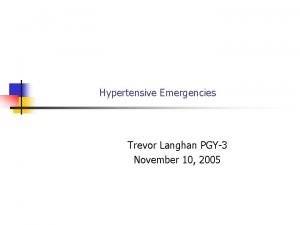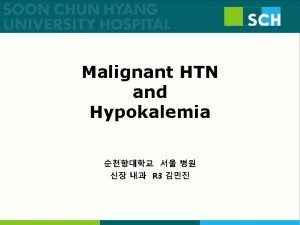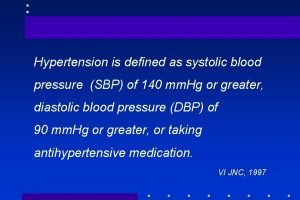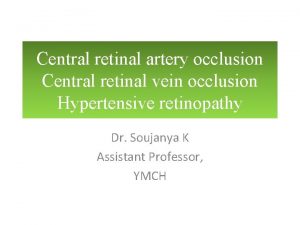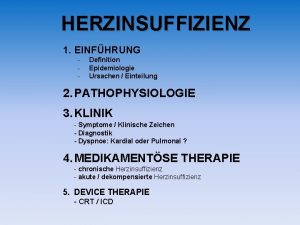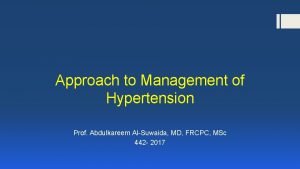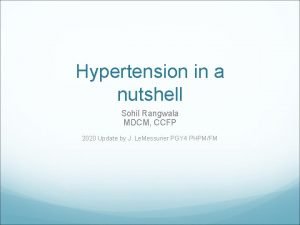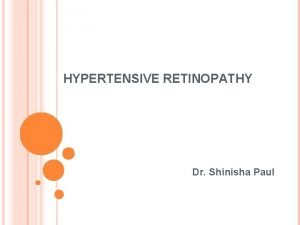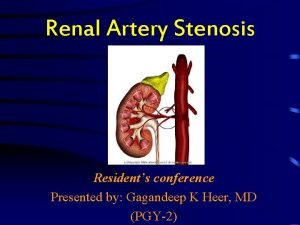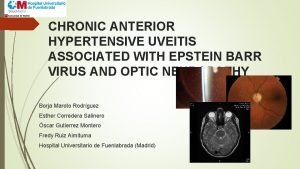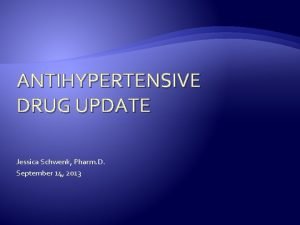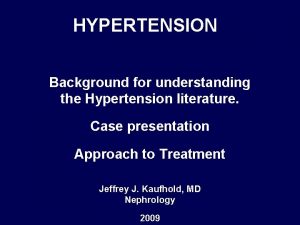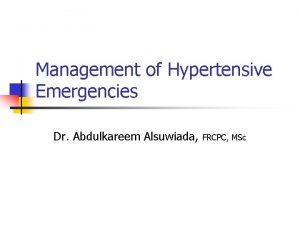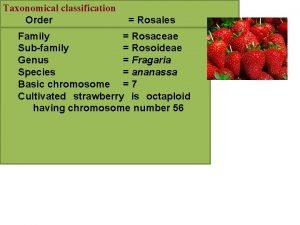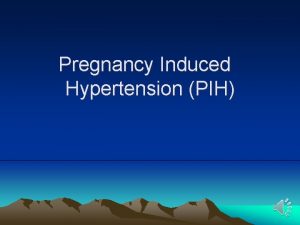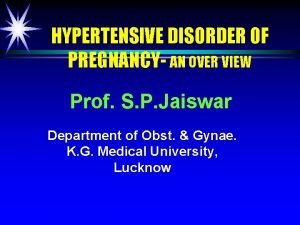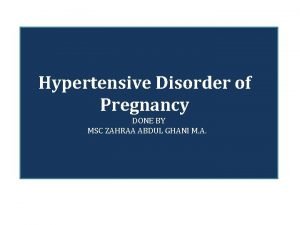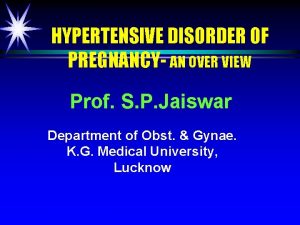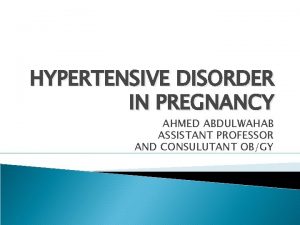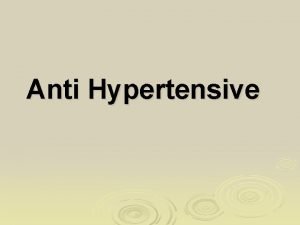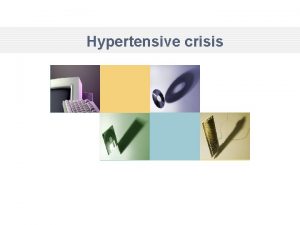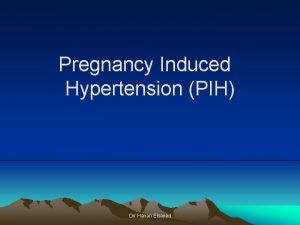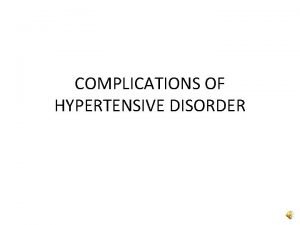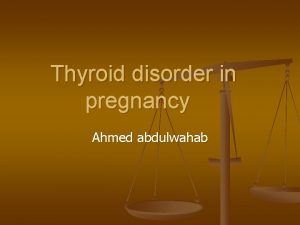Hypertensive Disorder in Pregnancy Classifications I Pregnancy induced






















- Slides: 22

Hypertensive Disorder in Pregnancy

�Classifications I. Pregnancy induced Hypertension HTN that develops as a consiequence of pregnancy. Includes: a. b. Gestational hypertension: which is elevation of B. P. without Pathological edema, proteinurea hematological/ or biochemical changes Pre-eclampsia: Which is elevation of BP with proteinuria and or patholigical edema, biochemical and or hematogical changes.

�Pre-eclampsia could be: a. b. Mild Severe c. Eclampsia. Convulsions II. Pregnancy aggravated HTN. Which is pre existing hypertension that got worse during pregnancy. a. Superimposed pre-eclampsia b. Superimposed eclampsia

III. HELLP Syndrome: Hemolysis Low platelets Elevated liver enzyme Physiological Changes in Blood pressure during pregnancy Slight drop in 1 st trimester which continuous through the 2 nd trimester, then gradual rise to pre-pregnancy level in the 3 rd trimester * HTN is never normal in pregnancy.

Picture I

�Definition: �BP > 140/90 after 20 weeks gestation in the sitting position an of 30 systolic, 15 diastolic is no longer used.

• Risk factors: Nulliparity Extremes of age Multifetal pregnancy Hydrops fetalis Diabetes Renal disease Auto immune disorders

�Pathophysiology: �Vaso spasms: � Vascular constriction causes resistance to blood flow and accounts for the development of arterial HTN


Vaso spam is due to the • production of thromboxane and production of prostocycline •



�Dietary dificiency of Ca.

�Different scopes of the disease have maternal and fetal manifestations to different extents. �I. Gestational HTN - May be asymptomatic - No edema - No protein urea - No hematological abormalities - No biochemical abnormalities - + Fetal involvement e. g. IUGR, oligohydramios in fetal heart tracing and BPP depending on the duration of the diseases. placental abruption, fetal death

�II. Pre-eclampsia: - Mild : BP < 160/110. Edema of the face and upper extremities. - Proteinuria > 300 mg /12 24 hours (trace to +1) - Severe : BP > 160/110 Proteinuria 4 -5 gm / hours (+ 2 or more) Headache Visual disturbance Epigastric pain Oliguria Pulmunary edema Platelets LFTS

�Fetal Involvement as previously mentioned. III. Eclampsia * Generalized tonic, clonic seizures * R/O epilepsy * Considered as a severe form IV. Pregnancy aggravated HTN with: * Super-imposed pre-eclampsia * Super-imposed eclampsia with fetal involvement

�V. HELLP SYNDROME �Severe form with rapid deterioration. �Active aggressive management regardless of gestation age. • Management: • Prevention : ANC • Aspirin • Diet • BP control in HTN patients


�Investigations: �CBC �U/A, 24 hour collection �LFTS �KFTS �Coagulation profile n. TREATMENT DEPENDS ON: 1. 2. Severity of the condition Fetal maturity

�In mild cases with prematurity conservative management is recommended with close fetal and maternal monitoring and administration of steroids. �In severe cases : Stabilization and delivery regardless of the fetal age is indicated �Mode of delivery depends on how much time you have.

�BASIC RULES: �Use on antihypertensive to prevent maternal CVA commonly used is I. V. hydralazine �Lasix should not be used �ACE inhibitors are contraindicated �Aldomet is used incases of chronic HTN �Use Mg, SO 4, for seizure prevention intrapartum and 24 hours postpartum �Dosage : 4 gm IV load followed by 2 gm/m postpartum infusion. �Continuous fetal monitoring �Ins, outs

�Monitoring of patients on Mg, SO 4 �Mg levels �U/O volume �Reflexes �Respiratory rate
 Ion ion interaction
Ion ion interaction Implantation spotting
Implantation spotting Malingering disorder
Malingering disorder Hypertensive encephalopathy
Hypertensive encephalopathy Hypertensive atherosclerotic cardiovascular disease
Hypertensive atherosclerotic cardiovascular disease Hypertensive crisis classification
Hypertensive crisis classification Thyroid storm nursing interventions
Thyroid storm nursing interventions Hypokalemia
Hypokalemia Calcium channel blockers examples
Calcium channel blockers examples Crvo
Crvo Hypertensive kardiopathie definition
Hypertensive kardiopathie definition Hypertension urgency vs emergency
Hypertension urgency vs emergency Diagnosing hypertension
Diagnosing hypertension Keith wegner classification
Keith wegner classification Malignant hypertension
Malignant hypertension Hypertensive uveitis
Hypertensive uveitis Hypertensive urgency vs emergency
Hypertensive urgency vs emergency Hypertensive emergency vs urgency
Hypertensive emergency vs urgency Rétinopathie hypertensive
Rétinopathie hypertensive Hypertensive urgency vs emergency
Hypertensive urgency vs emergency Daffodil drugs
Daffodil drugs Rosales classification
Rosales classification Plants are classified as
Plants are classified as



